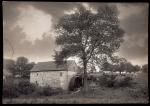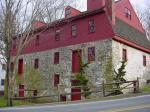![header=[Marker Text] body=[The stone gristmill at this site was built in 1704 by Nathaniel Newlin, a Quaker who emigrated from Ireland in 1683. The mill, restored to working order, is a fine example of vital segment of Colonial economic life. ] sign](http://explorepahistory.com/kora/files/1/10/1-A-166-139-ExplorePAHistory-a0a8o7-a_450.gif)
Mouse over for marker text
Name:
Colonial Gristmill
Region:
Philadelphia and its Countryside/Lehigh Valley
County:
Delaware
Marker Location:
US 1, 1 mile E of Concordville.
Dedication Date:
May 5, 1959
Behind the Marker
Pennsylvania's reputation as the "best poor man's country" in the world rested on the fertility of its soil and development of a commercial grain trade across the Atlantic world. Pennsylvania led Britain's North American colonies in the production of wheat, its most important export. The first and most important of these markets was the West Indies, especially Britain's "sugar" colonies of Barbados and Jamaica. After 1750 Philadelphia merchants developed important secondary markets in the "Wine Islands" of the eastern Atlantic (the Azores, Canary Islands, and Madeira), and with areas of southern and Mediterranean Europe where populations were booming at the same time that wars were causing major crop failures. The profits and capital accumulated from these foreign markets fueled the growth and gentrification of Philadelphia, and helped fund commercial enterprises elsewhere in the colony, including a vibrant iron industry.
Eastern Pennsylvania was blessed with numerous fast-flowing streams that provided the water power necessary to grind grain into flour. Gristmills were found in virtually all southeastern Pennsylvania townships after 1700. Chester County alone could boast of 127 such mills by 1781. Most of these mills were "country mills," grinding course grains for local and domestic consumption. Larger "merchant mills," often with multiple grinding stones and sophisticated and expensive "boulting cloths," also existed in the Wilmington area on the Brandywine Creek and at Frankford, in Philadelphia County. These produced finer flours for export to the Atlantic markets. Newlin Mill is an example of a "country mill," grinding grain for use on local farms and occasionally for sale in Philadelphia or other market towns. It was the third of three mills built by the Newlin family, Quakers who immigrated to Pennsylvania from Mountmellick, Queens County, Ireland, in the early 1680s.
William Penn's recruitment of the Newlin family to settle in Pennsylvania illustrates how widely the Quaker proprietor cast his net in seeking to build a New World colony. Nathaniel Newlin, the builder of the gristmill, was a child when he arrived in America. Having come of age and married, he built the mill in 1704 on a tract of land on the Chester Creek in Concord Township, Chester County. Rural grist mills often became local business centers. Like many other millers, Newlin later owned a store and became something of a land speculator, as European immigrants began filling up the fertile lands in the three original eastern counties surrounding Philadelphia. After Newlin died in 1729, the mill remained in the family, grinding wheat, corn, oats, buckwheat, and rye into the early 1800s.
Chester County. Rural grist mills often became local business centers. Like many other millers, Newlin later owned a store and became something of a land speculator, as European immigrants began filling up the fertile lands in the three original eastern counties surrounding Philadelphia. After Newlin died in 1729, the mill remained in the family, grinding wheat, corn, oats, buckwheat, and rye into the early 1800s.
Not much is known about the role of the Newlin grist mill in the Revolutionary War. Mill sites were places of critical struggle for the control of local resources by both the Redcoat and Continental armies, especially during the Philadelphia campaign of 1777-1778. General Washington at one point ordered his officers to remove the stones from local mills to prevent millers from grinding flour for the enemy, or to reduce General Howe's temptation to attack those sites. The effect of this order on the Newlin Mill, however, is unknown.
Since the Newlins belonged to the Religious Society of Friends, which prohibited members from involving themselves in any way with the war effort, the family may well have refused to supply either army with grain, despite their desperate need for food. If this was the case, the Newlins were probably under great pressure from both armies on September 11, 1777, as their mill was on the edge of the Brandywine Battlefield.
In the mid-1900s, a nonprofit family foundation restored the Newlin Grist Mill. Today, the property encompasses some 150 acres and includes a blacksmith shop, miller's house, barn, and grain storage building, in addition to the working grist mill. Located at 219 South Cheyney Road in Glen Mills, the mill is open to the public year round and continues to serve as an important symbol of the economic dimension of war and revolution, as well as the peace and prosperity of early Pennsylvania.
Eastern Pennsylvania was blessed with numerous fast-flowing streams that provided the water power necessary to grind grain into flour. Gristmills were found in virtually all southeastern Pennsylvania townships after 1700. Chester County alone could boast of 127 such mills by 1781. Most of these mills were "country mills," grinding course grains for local and domestic consumption. Larger "merchant mills," often with multiple grinding stones and sophisticated and expensive "boulting cloths," also existed in the Wilmington area on the Brandywine Creek and at Frankford, in Philadelphia County. These produced finer flours for export to the Atlantic markets. Newlin Mill is an example of a "country mill," grinding grain for use on local farms and occasionally for sale in Philadelphia or other market towns. It was the third of three mills built by the Newlin family, Quakers who immigrated to Pennsylvania from Mountmellick, Queens County, Ireland, in the early 1680s.
William Penn's recruitment of the Newlin family to settle in Pennsylvania illustrates how widely the Quaker proprietor cast his net in seeking to build a New World colony. Nathaniel Newlin, the builder of the gristmill, was a child when he arrived in America. Having come of age and married, he built the mill in 1704 on a tract of land on the Chester Creek in Concord Township,
Not much is known about the role of the Newlin grist mill in the Revolutionary War. Mill sites were places of critical struggle for the control of local resources by both the Redcoat and Continental armies, especially during the Philadelphia campaign of 1777-1778. General Washington at one point ordered his officers to remove the stones from local mills to prevent millers from grinding flour for the enemy, or to reduce General Howe's temptation to attack those sites. The effect of this order on the Newlin Mill, however, is unknown.
Since the Newlins belonged to the Religious Society of Friends, which prohibited members from involving themselves in any way with the war effort, the family may well have refused to supply either army with grain, despite their desperate need for food. If this was the case, the Newlins were probably under great pressure from both armies on September 11, 1777, as their mill was on the edge of the Brandywine Battlefield.
In the mid-1900s, a nonprofit family foundation restored the Newlin Grist Mill. Today, the property encompasses some 150 acres and includes a blacksmith shop, miller's house, barn, and grain storage building, in addition to the working grist mill. Located at 219 South Cheyney Road in Glen Mills, the mill is open to the public year round and continues to serve as an important symbol of the economic dimension of war and revolution, as well as the peace and prosperity of early Pennsylvania.






